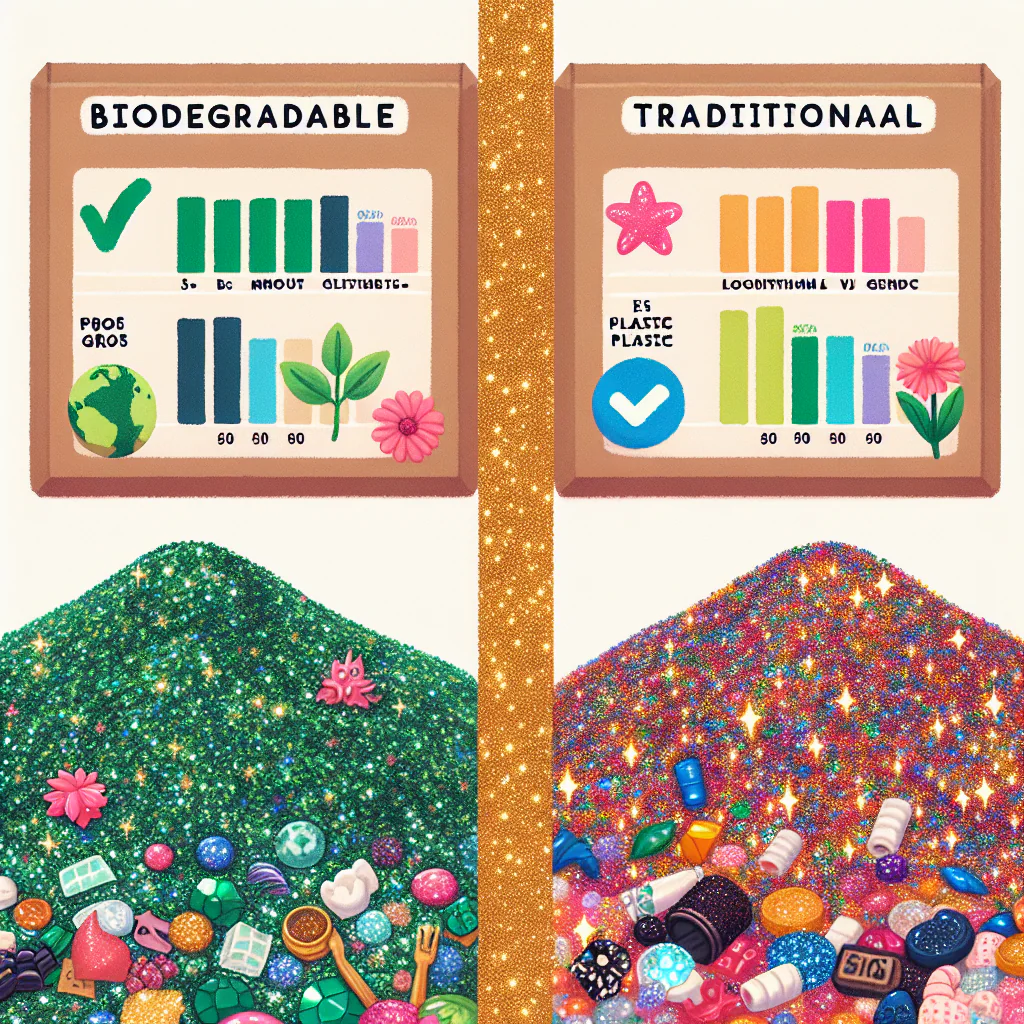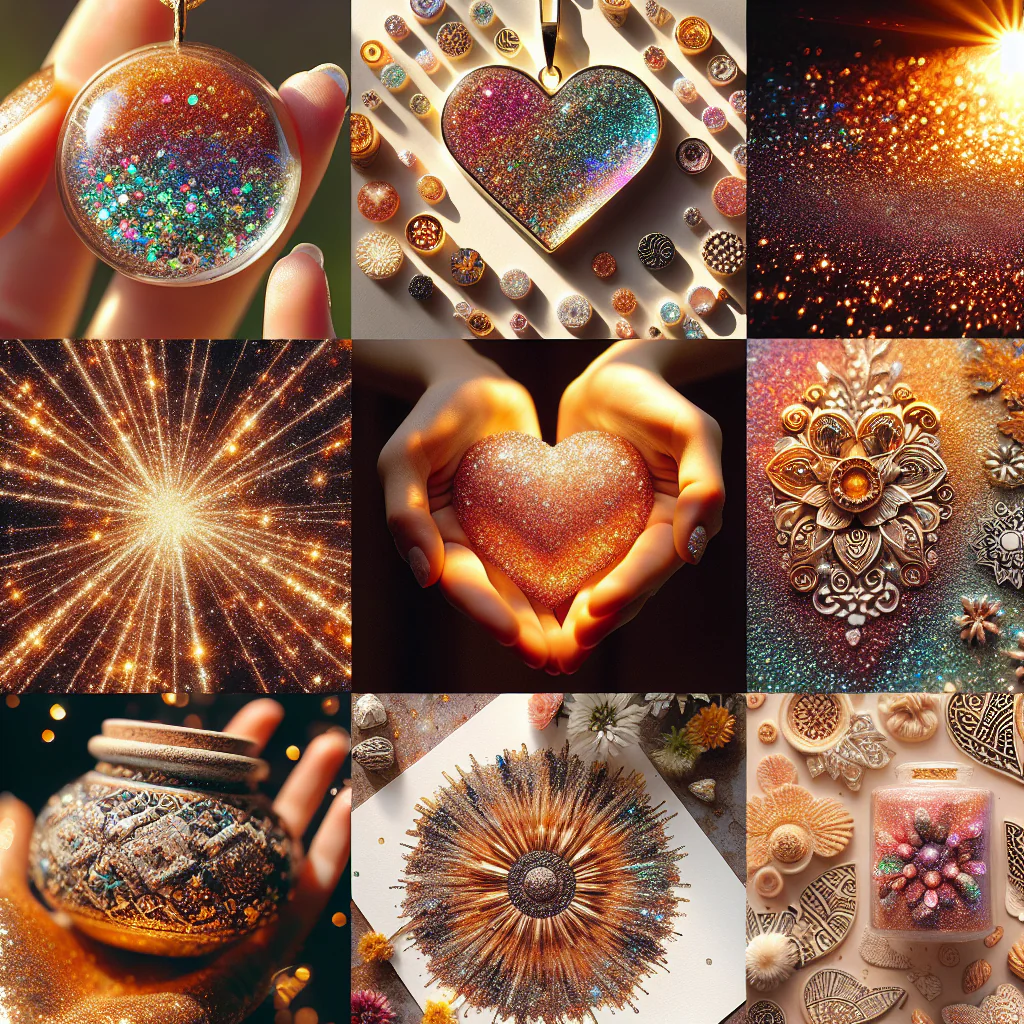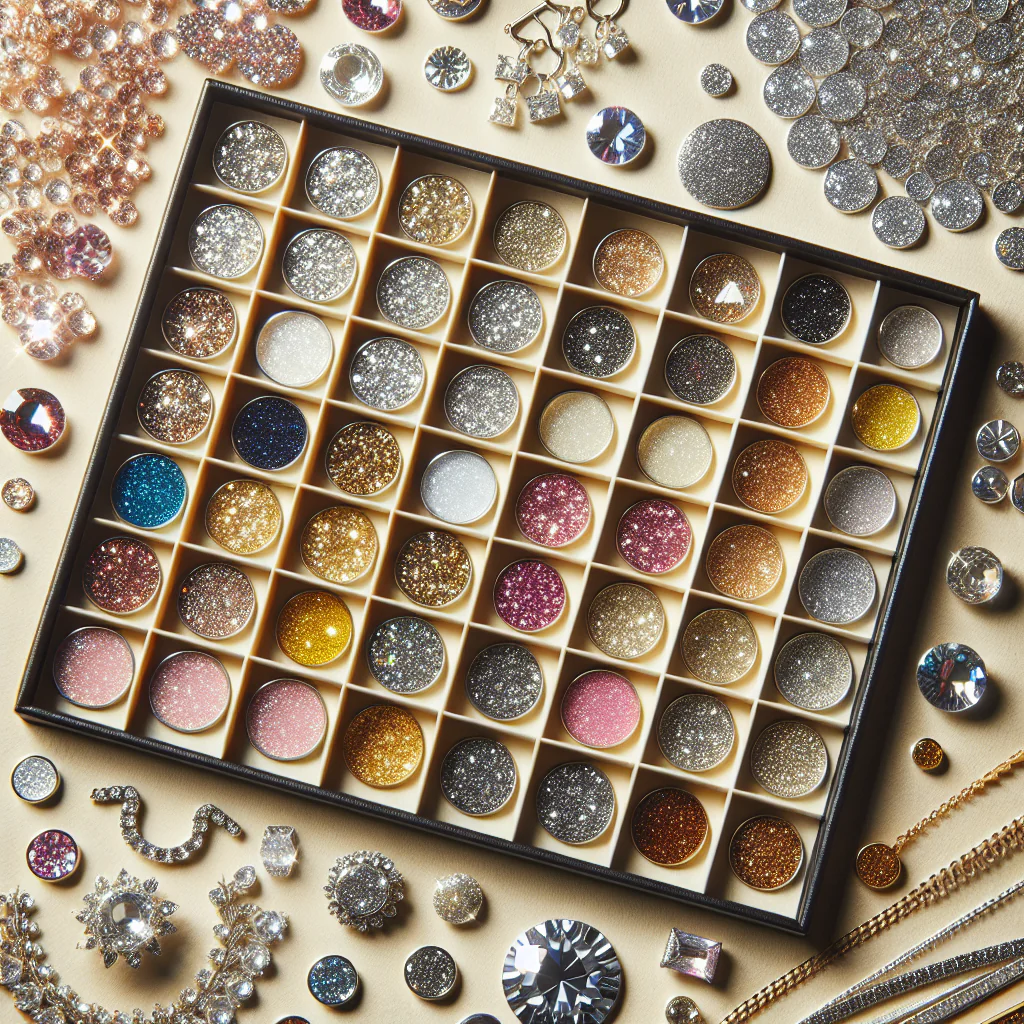-
Table of Contents
“Choose sustainability and sparkle with biodegradable glitter.”
Introduction
Glitter has been a popular decorative material for decades, adding a touch of sparkle and shine to various products and events. However, with growing concerns about the environmental impact of traditional glitter, a new alternative has emerged – biodegradable glitter. In this comparison, we will explore the differences between biodegradable glitter and traditional glitter, and help you determine which option is the right choice for you.
Benefits of Biodegradable Glitter: Why It’s a Sustainable Choice
Glitter has been a staple in the world of arts and crafts, fashion, and beauty for decades. Its shiny and sparkly appearance adds a touch of glamour and fun to any project or outfit. However, the traditional glitter that we all know and love is made from tiny pieces of plastic, known as microplastics, which can have a detrimental impact on the environment. This has led to the rise of biodegradable glitter as a more sustainable alternative. In this article, we will explore the benefits of biodegradable glitter and why it is a better choice for the environment.
First and foremost, biodegradable glitter is made from natural and plant-based materials, such as eucalyptus cellulose, making it biodegradable and compostable. This means that when it is disposed of, it will break down into natural elements without leaving behind harmful microplastics. On the other hand, traditional glitter is made from non-biodegradable materials, such as polyester, which can take hundreds of years to decompose. This poses a significant threat to our environment, as these microplastics can end up in our oceans and harm marine life.
Moreover, the production of biodegradable glitter has a lower carbon footprint compared to traditional glitter. The process of making traditional glitter involves the use of fossil fuels, which release harmful greenhouse gases into the atmosphere. In contrast, biodegradable glitter is produced using renewable energy sources, such as solar or wind power, making it a more sustainable option. This not only reduces the carbon emissions but also helps in the fight against climate change.
In addition to being environmentally friendly, biodegradable glitter is also safer for our health. Traditional glitter is often coated with aluminum and other harmful chemicals, which can cause skin irritation and allergic reactions. Biodegradable glitter, on the other hand, is free from these chemicals, making it safe for use on the skin. This is especially important for children, who are more susceptible to skin sensitivities.
Furthermore, biodegradable glitter is versatile and can be used in a variety of applications, just like traditional glitter. It can be used in arts and crafts, as well as in the beauty industry for makeup and nail art. The only difference is that biodegradable glitter is a more sustainable option, without compromising on its sparkly and vibrant appearance. This makes it a win-win situation for both the environment and our creative endeavors.
Another benefit of biodegradable glitter is that it is easier to clean up. Traditional glitter has a notorious reputation for being difficult to remove, often ending up in places where it shouldn’t be. Biodegradable glitter, on the other hand, can be easily cleaned up with water, as it dissolves and breaks down into natural elements. This not only saves us time and effort but also prevents the glitter from ending up in our waterways and harming marine life.
Lastly, using biodegradable glitter sends a powerful message about our commitment to sustainability. By choosing to use biodegradable glitter, we are making a conscious effort to reduce our impact on the environment and protect our planet for future generations. It also sets a good example for others to follow, encouraging them to make more sustainable choices in their daily lives.
In conclusion, the benefits of biodegradable glitter are numerous, making it a clear winner over traditional glitter. Its eco-friendly production, safe and versatile use, and easy clean-up make it a more sustainable choice for all our glitter needs. So the next time you reach for that sparkly jar of glitter, consider making the switch to biodegradable glitter and do your part in protecting our planet.
The Environmental Impact of Traditional Glitter: Why It’s Time to Make a Change

Glitter has been a staple in the world of arts and crafts, fashion, and beauty for decades. Its shiny and sparkly appearance adds a touch of glamour and fun to any project or outfit. However, what many people don’t realize is that traditional glitter is made from tiny pieces of plastic, known as microplastics, which have a significant impact on the environment.
Microplastics are small plastic particles that are less than 5 millimeters in size. They are commonly found in products such as cosmetics, cleaning products, and even clothing. Traditional glitter is made from these microplastics, which are often not biodegradable and can take hundreds of years to break down. This means that every time we use glitter, we are contributing to the growing problem of plastic pollution.
When glitter is washed down the drain, it ends up in our waterways and oceans, where it can harm marine life. Fish and other marine animals often mistake microplastics for food, which can lead to serious health issues and even death. Additionally, microplastics can absorb toxic chemicals and pollutants, making them even more harmful to the environment.
Moreover, the production of traditional glitter also has a negative impact on the environment. The process of creating glitter involves using large amounts of energy and resources, which contribute to carbon emissions and climate change. The use of non-renewable resources, such as petroleum, in the production of glitter also adds to its environmental impact.
The environmental impact of traditional glitter is undeniable, and it’s time for us to make a change. This is where biodegradable glitter comes in. Biodegradable glitter is made from plant-based materials, such as eucalyptus cellulose, which are biodegradable and compostable. This means that they can break down naturally without causing harm to the environment.
One of the main benefits of biodegradable glitter is that it does not contribute to plastic pollution. When washed down the drain, it will break down into natural materials, leaving no harmful residue behind. This makes it a much more environmentally friendly option compared to traditional glitter.
Furthermore, the production of biodegradable glitter is also more sustainable. It requires less energy and resources to produce, making it a more eco-friendly choice. Additionally, some companies that produce biodegradable glitter also have sustainable practices in place, such as using renewable energy sources and reducing their carbon footprint.
But is biodegradable glitter as sparkly and fun as traditional glitter? The answer is yes! Biodegradable glitter comes in a variety of colors and sizes, just like traditional glitter. It is just as shiny and sparkly, making it a perfect alternative for all your glitter needs.
Some may argue that biodegradable glitter is more expensive than traditional glitter. While this may be true in some cases, the long-term benefits of using biodegradable glitter outweigh the initial cost. By choosing biodegradable glitter, you are making a conscious effort to reduce your environmental impact and contribute to a cleaner and healthier planet.
In conclusion, the environmental impact of traditional glitter is significant, and it’s time for us to make a change. Biodegradable glitter offers a sustainable and eco-friendly alternative that does not compromise on its sparkly and fun qualities. By choosing biodegradable glitter, we can all do our part in reducing plastic pollution and creating a more sustainable future. So the next time you reach for glitter, consider making the switch to biodegradable glitter and make a positive impact on the environment.
Making the Switch: How to Incorporate Biodegradable Glitter into Your Beauty Routine
Glitter has been a staple in the beauty industry for decades. From eye shadows to nail polishes, it adds a touch of sparkle and glamour to any look. However, traditional glitter is made from microplastics, which are harmful to the environment and can take hundreds of years to decompose. This has led to the rise of biodegradable glitter as a more eco-friendly alternative. But with so many options available, how do you know which type of glitter is right for you? In this article, we will explore the differences between biodegradable glitter and traditional glitter, and provide tips on how to incorporate biodegradable glitter into your beauty routine.
First, let’s understand what biodegradable glitter is. Unlike traditional glitter, which is made from plastic, biodegradable glitter is made from plant-based materials such as eucalyptus cellulose or algae. These materials are biodegradable, meaning they can break down naturally without causing harm to the environment. This makes biodegradable glitter a more sustainable option for those who love to add a touch of sparkle to their makeup looks.
One of the main concerns with traditional glitter is its impact on the environment. When washed down the drain, it can end up in our oceans and harm marine life. Biodegradable glitter, on the other hand, breaks down into harmless substances, reducing its impact on the environment. This is why many beauty brands are now making the switch to biodegradable glitter in their products.
So, how do you know if biodegradable glitter is the right choice for you? It ultimately depends on your personal values and priorities. If you are someone who is conscious about the environment and wants to make more sustainable choices, then biodegradable glitter is definitely worth considering. It allows you to still enjoy the sparkle and shine without contributing to plastic pollution.
Now, let’s talk about how you can incorporate biodegradable glitter into your beauty routine. The good news is that it can be used in the same way as traditional glitter. You can still use it on your eyes, lips, and nails to add a pop of color and shine. However, there are a few things to keep in mind when using biodegradable glitter.
Firstly, make sure to check the label and ensure that the glitter is truly biodegradable. Some products may claim to be biodegradable but still contain plastic particles. Look for certifications such as “OK Biodegradable WATER” or “OK Biodegradable SOIL” to ensure that the glitter is truly eco-friendly.
Secondly, when applying biodegradable glitter, use a water-based adhesive instead of oil-based ones. This will help the glitter stick to your skin without causing any harm to the environment. You can also opt for glitter gels or creams that already have the adhesive mixed in, making it easier to apply.
Another tip is to avoid using glitter on open wounds or near your eyes. While biodegradable glitter is generally considered safe, it’s always better to err on the side of caution. If you have sensitive skin, it’s also a good idea to do a patch test before using biodegradable glitter on your face.
Lastly, when removing biodegradable glitter, avoid using makeup wipes or cotton pads as they can end up in landfills and take a long time to decompose. Instead, use a damp cloth or a biodegradable makeup remover to gently wipe off the glitter.
In conclusion, biodegradable glitter is a more sustainable option for those who love to add some sparkle to their beauty routine. It’s better for the environment and still allows you to achieve the same glamorous looks as traditional glitter. By making small changes in our beauty routines, we can all contribute to a cleaner and healthier planet. So, next time you reach for that glitter, consider making the switch to biodegradable glitter and make a positive impact on the environment.
Q&A
1. What is the main difference between biodegradable glitter and traditional glitter?
The main difference between biodegradable glitter and traditional glitter is that biodegradable glitter is made from natural and plant-based materials, while traditional glitter is typically made from plastic or metal.
2. Why is biodegradable glitter considered a more environmentally friendly option?
Biodegradable glitter is considered more environmentally friendly because it breaks down naturally over time, unlike traditional glitter which can take hundreds of years to decompose and can harm the environment and wildlife.
3. Are there any downsides to using biodegradable glitter?
One potential downside to using biodegradable glitter is that it may not have the same level of shine and sparkle as traditional glitter. Additionally, some biodegradable glitter may not be suitable for use on certain materials or in certain applications, so it’s important to check the product’s specifications before use.
Conclusion
In conclusion, the choice between biodegradable glitter and traditional glitter ultimately depends on personal values and priorities. Biodegradable glitter offers a more environmentally friendly option, as it breaks down naturally without harming the environment. On the other hand, traditional glitter may have a wider range of colors and effects, but it can contribute to pollution and harm to wildlife. It is important for individuals to consider the impact of their glitter use and make a conscious decision based on their values. Ultimately, both options have their own benefits and drawbacks, and it is up to the consumer to decide which is the right choice for them.







